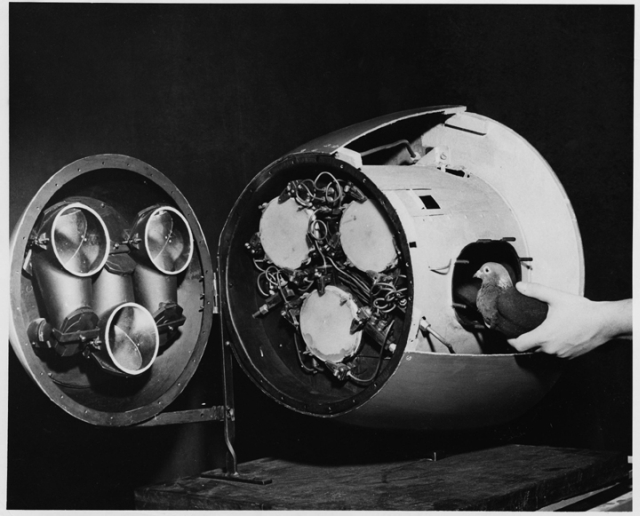At the decline of World War I in 1918, during the battle of Argonne in France, 500 Allied soldiers were trapped. Protected only by a several-foot heap of soaking mud, German shells and bullets whizzed over their heads and zipped through the soggy clay. Their only food supply consisted of a few crusts of bread carpeted in dark grey, bristling mold. Days dragged on, yet no Allies knew of the starving soldiers. Charles Whittlesey, the leader of the trapped Allied division, had no means of communicating their location except for three carrier pigeons. The remaining soldiers gazed up in hope as one pigeon, with a message attached to its leg, soared upwards. However, no sooner had the pigeon left the trench when Germans spotted it and sent it crashing to the ground in a flurry of bullets. After the death of the second pigeon, the remaining 194 soldiers’ only chance to live depended on one pigeon, Cher Ami. She flew several miles, surrounded in storms of bullets. One tore through her leg and another ripped through her chest. Her strength faded and gave way to pain as she spiraled down to the ground. Then, she managed to draw a last ounce of strength, fight against the whizzing shells, and soar above the enemy fire. With her leg dangling by a tendon and a gap in her chest, Cher Ami still managed to deliver the message. This message saved the lives of all 194 soldiers, and Cher Ami became a war hero. Medics scrambled to save her life, but could not save her leg. Cher Ami was sent to the U.S, and died six months later from her injuries. The story of Cher Ami shows that even animals regarded as common and insignificant can have a great impact on the world.
Although pigeons have been used in warfare for centuries, behavior psychologist Frederic Skinner devised a new, revolutionary use of pigeons in World War II. When the Germans bombed Poland in 1939, Skinner wondered if missiles and shells could be guided to a target from an aircraft. He found his answer not in extensive research, but in his own back yard. As he watched a flock of birds settle to the ground, and then lift off in a moving carpet, Skinner “saw them as `devices’ with excellent vision and extraordinary maneuverability,” and wondered if they could be trained to guide a missile. He decided to use birds because of their superior eyesight to humans, agile movements, and ability to remain comfortable in the air. Skinner then chose to focus on pigeons for their predictability. He taught the pigeons to peck at a target image to earn pieces of grain. Once the pigeons were conditioned to peck the target, Skinner built a steering system of lightweight rods strapped to the pigeon’s neck. When it lunged to tap the target image, the rods closed an electrical contact, moving the missile. When the target moved off-center, the pigeon would poke vehemently at it, steering the missile back on its course. Convinced that his idea could help end the war with fewer deaths, Skinner submitted his project to the National Inventors Council, but was met with refusal. Undeterred, he sent a proposal to Office of Scientific Research and Development, and, this time, was accepted. Before being implemented, Skinner tested the pigeon-guided missiles under conditions simulating those in battle. Pistols were fired, barely grazing the birds’ heads, yet their eyes remained fixed on the target and they barely even shifted a toe. They were also subjected to blinding, white flashes simulating shell bursts, but their minds remained intent on receiving a kernel of grain. Even when Skinner placed a pigeon of the opposite gender beside the missile commander, the pigeon’s hunger overcame all desires, and it hammered away at the target without stealing a glance. “There could scarcely have been a better demonstration of the extraordinary predictability of behavior, the keenness of a pigeon’s vision, the accuracy of its responses, and its freedom from distraction.” Despite the promising prospects of Project Pigeon, it was canceled, thought to “seriously delay others...which have more immediate promise.”
The results of the Project Pigeon experiments indicate that Project Pigeon may have been a tremendous success. Perhaps World War II may have ended sooner with far fewer deaths if Project Pigeon was implemented. Even animals such as pigeons that we often take for granted, or even consider a nuisance, could have a drastic impact on the world. Cher Ami alone saved 194 lives, and, if pigeons were used to command missiles, they could have saved hundreds more.
Are you interested to read more tales of animal spies including bats, cats, dolphins, and mosquitoes? If so, you can check out my book, Sneaky Creatures, on Amazon: http://www.amazon.com/Sneaky-Creatures-Amazing-tales-animal/dp/1518673856/ref=sr_1_3?ie=UTF8&qid=1459791360&sr=8-3&keywords=sneaky+creatures



No comments:
Post a Comment